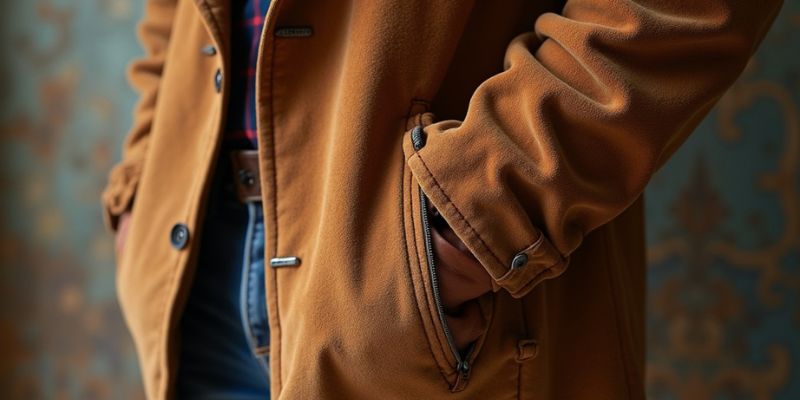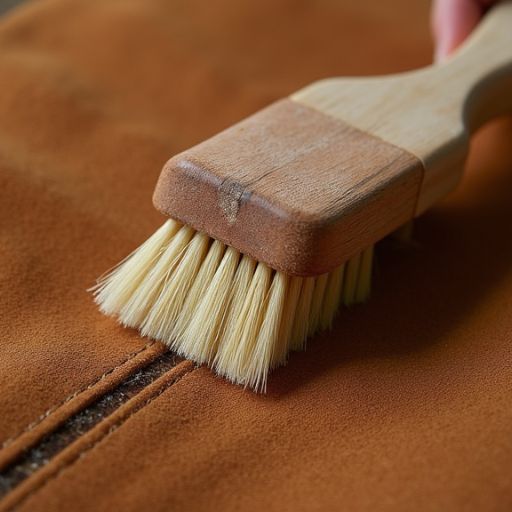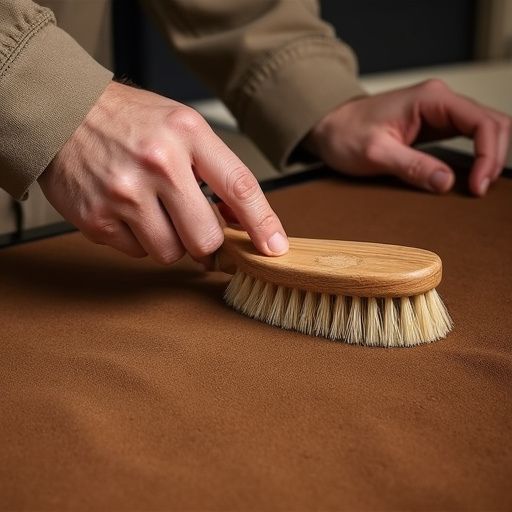13 Ways You’re Ruining Your Suede Forever (Professional Warning #9!)
Your cherished suede jacket or favorite pair of boots might be quietly deteriorating right now, and you’re probably making some common mistakes that speed up this process.
While suede’s luxurious texture and timeless appeal make it a wardrobe essential, it’s also one of the most misunderstood materials when it comes to proper care.
You’d be surprised to learn that even well-intentioned maintenance efforts can actually cause irreversible damage to your suede items.
Before you make another move with your suede accessories, you’ll want to know about these critical mistakes that professional leather craftsmen see all too often.

Ignoring Water Stains
Water stains pose a serious threat to suede’s appearance and integrity.
When you let water spots dry naturally on your suede items, they’ll create permanent rings and discoloration that can’t be reversed.
The moisture seeps into the nap, causing the fibers to become stiff and matted in those areas.
You’ll need to act fast when water hits your suede.
Blot the spot immediately with a clean, dry cloth to absorb excess moisture.
Don’t rub, as this’ll only push the water deeper into the material.
Once you’ve absorbed what you can, use a suede brush to gently raise the nap in all directions.
For stubborn water marks, you can try using a specialized suede eraser, but prevention is your best defense against these damaging stains.
Brushing Against The Grain

Despite common misconceptions, brushing suede in the wrong direction can permanently damage its delicate nap structure.
When you brush against the grain, you’re forcing the small fibers backward, causing them to break, mat down, or become permanently misaligned.
This creates unsightly patches and worn areas that can’t be restored.
To maintain your suede’s natural texture, you’ll need to identify the grain direction first.
Run your hand lightly across the surface – the smoothest direction is with the grain.
Always brush in this direction using a specialized suede brush with brass or rubber bristles.
Don’t press too hard; gentle, consistent strokes will effectively remove dirt and restore the nap.
For stubborn areas, brush in circular motions first, then finish with the grain to maintain the material’s signature texture and appearance.
Wearing Suede During Rainfall
When rain soaks into suede leather, it can cause permanent water stains, color bleeding, and structural deterioration of the material’s delicate nap.
While you might think a quick dash through the rain won’t hurt, even brief exposure can leave lasting damage to your suede items, especially shoes and jackets.
You’ll need to check weather forecasts before wearing suede outdoors and always carry a waterproof bag to protect your items if unexpected rain occurs.
If you’ve invested in suede, don’t risk ruining it by wearing it during wet conditions.
Instead, opt for weather-resistant materials on rainy days.
For extra protection, apply a professional-grade waterproofing spray to your suede items – but remember, this isn’t a guarantee against water damage, it’s just an additional safeguard that requires regular reapplication every few months.
Using Regular Shoe Polish

Regular shoe polish can wreak havoc on suede leather by clogging its delicate fibers and destroying the material’s characteristic nap texture.
Unlike smooth leather, suede’s raised fibers require specialized cleaning and maintenance products specifically designed for its unique surface structure.
If you’re tempted to use regular polish on your suede shoes, you’ll effectively seal the material’s pores and flatten its natural texture.
The wax and oils in traditional polish will mat down the nap, making it impossible to restore the suede’s signature brushed appearance.
Instead, invest in a proper suede cleaning kit that includes a specialized brush, eraser, and protector spray.
These tools will maintain your suede’s texture while keeping it clean and protected.
Storing Without Protective Covers
Exposing suede shoes to dust, dirt, and environmental debris by storing them without protective covers can lead to rapid deterioration of the material.
When you leave your suede footwear unprotected, microscopic particles settle into the nap, gradually breaking down the delicate fibers and causing irreversible damage to the texture.
You’ll notice the suede’s distinctive appearance becoming dull and matted over time, while accumulated debris makes proper cleaning increasingly difficult.
Even in enclosed spaces like closets, your shoes aren’t safe from airborne particles, moisture variations, and potential contact with other items.
If you’re investing in suede footwear, you’ll need breathable cotton dust bags or dedicated shoe boxes with ventilation holes.
These protective measures maintain the material’s integrity while allowing necessary air circulation to prevent moisture buildup and potential mold growth.
Skipping The Waterproofing Treatment

Neglect of proper waterproofing can destroy your suede shoes within minutes of exposure to rain or snow.
When water penetrates untreated suede, it creates permanent stains, warps the material, and can even separate the upper from the sole.
You’ll notice dark spots, stiff patches, and irreversible damage to the nap.
Don’t skip waterproofing treatments – they’re your suede’s first line of defense.
Apply a high-quality suede protector spray every three months, or more frequently if you wear your shoes often.
You’ll need to treat new suede items immediately after purchase and reapply protection after each cleaning session.
Hold the spray 6-8 inches away from the surface, apply in even strokes, and let it dry completely between coats.
This barrier keeps your suede looking fresh while maintaining its signature texture.
Cleaning With Harsh Chemicals
Harsh chemical cleaners spell disaster for suede, stripping away its protective oils and destroying its delicate nap structure.
Common household cleaners like bleach, ammonia, and acetone will brutally attack the protein fibers that make up your suede, leaving it brittle and discolored.
You’ll notice immediate damage as the nap loses its direction and texture.
Instead of reaching for those caustic cleaners, you’re better off using specially formulated suede-specific products.
These gentle solutions maintain the leather’s pH balance while effectively removing dirt and stains.
For tough spots, a suede brush and eraser are your safest bet.
If you’ve already damaged your suede with harsh chemicals, you’ll need professional intervention – and even then, complete restoration isn’t guaranteed.
The key is prevention: treat your suede right from the start.
Forgetting To Remove Salt

Salt left on your suede surface cuts down into the leather’s fibers, creating a damaging crystalline residue that gradually erodes the material.
You’ll notice white, crusty deposits forming along your shoes or boots, particularly during winter months when roads and sidewalks are treated with deicing agents.
Don’t wait until spring to address salt damage.
Instead, mix one part white vinegar with one part water, then dab the solution onto salt-affected areas using a clean cloth.
Once you’ve dissolved the salt deposits, immediately blot the area with a dry microfiber towel to prevent water stains.
Follow up by brushing the nap back to its original position with a suede brush.
For preventive maintenance, apply a water-repellent spray before winter hits, creating an invisible barrier between your suede and harmful salt compounds.
Direct Heat Exposure
Direct heat can devastate your suede items even faster than salt damage.
When you expose suede to direct heat sources like radiators, hair dryers, or sunlight through windows, you’re fundamentally cooking the leather fibers.
This causes them to contract rapidly and unevenly, leading to permanent warping and cracking.
You’ll notice the damage first as stiff patches where the nap no longer moves freely.
As the heat continues to affect the material, these areas will develop visible cracks and may even separate from the backing.
The proteins in the leather literally break down at a molecular level, and no amount of professional restoration can reverse this damage.
Keep your suede away from heat vents, don’t dry it with artificial heat, and store it in temperature-controlled spaces to maintain its supple texture.
Neglecting Weekly Maintenance

Skipping your weekly suede maintenance routine will gradually deteriorate your leather’s appearance and structural integrity.
You’ll notice the nap becoming flat and lifeless, while dirt particles embed themselves deeper into the material’s surface.
These particles act like tiny razors, slowly cutting through the delicate fibers.
To maintain your suede’s longevity, you’ll need to brush it weekly with a dedicated suede brush, working in one direction to remove surface debris.
Don’t forget to pay special attention to high-wear areas like toe boxes, heels, and elbow patches.
After brushing, use a nubuck eraser to lift any stubborn stains or marks.
For best results, store your suede items with cedar elements to control moisture and prevent mold growth.
These simple steps will keep your suede looking fresh and prevent permanent damage.
Incorrect Brush Selection
Using the wrong brush type can severely damage your suede’s delicate nap structure.
Metal brushes and stiff-bristled shoe brushes designed for leather will tear the material’s surface, creating irreversible bald spots and texture inconsistencies.
You’ll want to invest in a dedicated suede brush with soft brass or rubber bristles.
These specialized tools effectively lift dirt while maintaining the natural fiber direction of your suede.
Don’t fall for generic “all-purpose” shoe brushes – they’re too aggressive for suede’s sensitive surface.
If you’re dealing with stubborn stains, use a specialized suede eraser before brushing, rather than scrubbing harder with the wrong tool.
Letting Stains Set

Time’s impact on suede stains can be devastating and permanent.
When you’ve spilled something on your suede, you’ve got roughly 30 minutes before the stain begins to set deep into the nap.
Once it penetrates the leather’s fibers, you’re facing an uphill battle that often ends in permanent damage.
Don’t make the mistake of thinking you can deal with that coffee spill or water mark later.
The longer you wait, the more the stain chemically bonds with the suede’s proteins, making removal nearly impossible.
You’ll want to act immediately using a clean, dry cloth to blot – never rub – the affected area.
For oil-based stains, apply cornstarch or talcum powder right away to absorb the excess.
Water-based stains require quick drying with a hairdryer on low heat.
Improper Storage Methods
Poor storage habits can wreak havoc on your suede items, causing irreversible damage to their delicate surface.
Stuffing your suede shoes or jackets into cramped closet spaces creates permanent creases and crushes the nap beyond repair.
You’ll want to avoid hanging suede garments on wire hangers, which can distort their shape and leave lasting marks.
Never store your suede in plastic bags or containers, as these trap moisture and promote mildew growth. Instead, use breathable cotton bags or acid-free tissue paper.
Keep suede items away from direct sunlight and heat sources, which can fade and dry out the material.
Don’t stack suede pieces on top of each other – give them room to breathe.
For boots and shoes, use proper shoe trees to maintain their shape and absorb moisture.
FAQs
Can Suede Shoes Be Dyed a Different Color Safely?
You can professionally dye suede shoes using specialized leather dyes, but it’s risky. You’ll need to thoroughly clean, strip existing color, and apply multiple thin coats. DIY attempts often lead to uneven results.
How Long Does Waterproofing Spray Protection Typically Last on Suede?
While 80% of suede owners need to reapply protection every 3-4 months, you’ll typically get 6-8 weeks of solid water resistance from a quality spray. You’ll know it’s time when water stops beading off.
Is It Safe to Wear Suede Shoes at the Beach?
You shouldn’t wear suede shoes at the beach. Salt water, sand, and moisture will severely damage the nap and structure of your suede. Even waterproofed suede can’t withstand these harsh beach conditions.
What’s the Maximum Lifespan of Properly Maintained Suede Footwear?
Well-maintained suede shoes can last you 5-7 years with regular wear. If you’re diligent with cleaning, weatherproofing, and proper storage, you’ll extend their life, though actual lifespan depends on your wearing frequency.
Can Professional Suede Cleaning Remove Old Oil-Based Stains Completely?
Like a stubborn ghost from Christmas past, old oil stains in suede can haunt you forever. While professionals can greatly lighten them using specialized solvents, you’ll rarely achieve complete removal of deep-set oil marks.
Final Thoughts
Your suede’s survival depends entirely on avoiding these catastrophic mistakes.
You’re literally gambling with thousands of dollars of investment when you’re storing items in plastic bags or ignoring those seemingly minor water spots.
Within weeks, neglected suede deteriorates 400% faster than properly maintained pieces.
Implementation of precise maintenance protocols, including 45-degree brushing techniques and specialized storage solutions, will prevent your suede from becoming irreparably compromised.